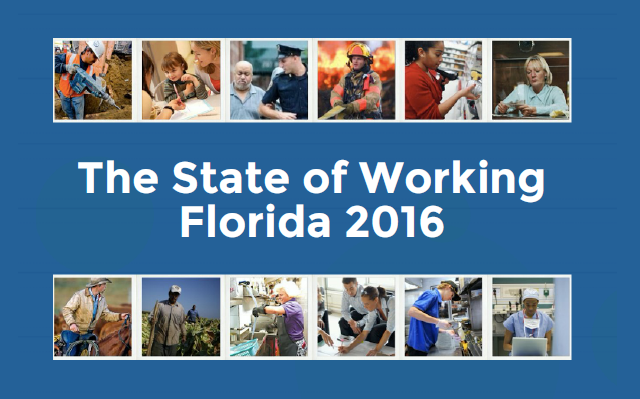FIU Study: The State of Working Florida 2016
Executive Summary
This 13th edition of State of Working Florida focuses on economic mobility in Florida through an analysis of the state’s occupational structure for the period between 2009 and 2014. This report concentrates on the occupational dynamics that have emerged in Florida after the Great Recession of 2007-2009 in order to explain the current path of economic and social development in the state.
Furthermore, the report addresses the implications of current occupational dynamics on future development and provides policy recommendations to improve economic mobility in Florida.
Key Findings:
- Between 2009 and 2014 the share of households that belonged to the upper class grew by 8.1 percent, from 17. 5 percent to 18.9 percent. Conversely, the middle class share declined by 3.5 percent during this period while the working class share grew by 1.1 percent. This means that the shrinking of the middle class was largely due to growth in the upper class and to a lesser extent, growth in the working class.
- As of 2014, the average upper class household earns three times what the average middle class household earns and nearly 10 times what the average working class family earns.
- The decline in household incomes experienced by the working class led to increased poverty rates among every demographic between 2009 and 2014.
- During the peak of the recession Florida’s unemployment rate rose to 11.2 percent in November 2009 and declined to 5.8 percent in December 2014 and 4.7 percent as of May 2016.
- Healthcare practitioner and technical jobs as well as computer and math occupations experienced the largest gains in shares of all jobs between 2009 and 2014. These occupations facilitate upward economic mobility.
- Sales and related occupations and office and administrative support jobs, the two largest occupational groups in the Florida, declined in their share of all jobs between 2009 and 2014, by 12.1 percent and13 percent respectively. These occupations facilitate upward mobility for working class and middle class workers.
- While some jobs continue to facilitate economic mobility, such as transportation and material moving jobs, sales and related occupations and office and administrative support jobs are not the robust bridges they once were.
- In 2014, the five main occupations of higher wage and salary earners are management, healthcare practitioners and technical jobs, sales and related jobs, business and financial operations, and computer and math occupations.
- The five main occupations of middle wage and salary workers are office and administrative support, sales and related occupations, management, education training, and library, and transportation and material moving jobs.
- The five main occupations of lower wage and salary earners are sales and related occupations, food preparative and service jobs, office and administrative support, building and ground cleaning and maintenance jobs, and transportation and material moving jobs.
- The average share of workers earning less than $10 per hour in their occupation grew from 16 percent in 2009 to 16.9 percent in 2014.
- The average share of workers earning less than $15 per hour in their occupation grew from 39.5 percent in 2009 to 40.9 percent in 2014.
- Women earn $0.78 for every $1 made by men, when controlling for age, education, and occupation.
- Racial and ethnic minorities earn $0.92 for every $1 made by whites, also controlling for age, education, and occupation.
- Policy recommendations include: paying higher wages to low-wage workers, stopping workplace discrimination, and improving educational outcomes, especially in college graduation rates.
Full report below…
~
4closureFraud.org
~
The State of Working Florida 2016


No Comment